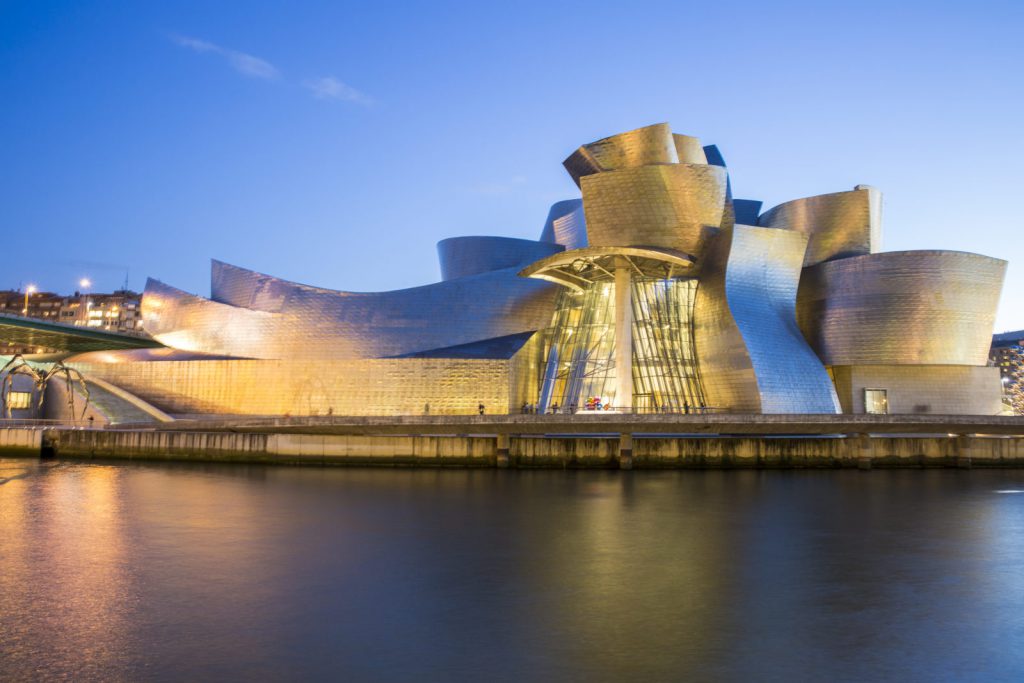
Published June 1, 2016
The New Criterion - May 2016 issue
Occasionally, reality catches up with hyperbole. Witness the case of Frank Gehry’s Winton Guest House, a topsy-turvy assembly of rectangles, cubes, and pyramids of different materials and colors, all jumbled together without any apparent rationale other than to be discordant and odd, a trait that has become a Gehry hallmark. In a new biography, Building Art: The Life and Work of Frank Gehry, the architectural critic Paul Goldberger (who has championed Gehry for decades) calls the Winton house a “significant milestone” in the architect’s career.1
Built for the wealthy art collectors Mike and Penny Winton (who first read about the architect in an article in The New York Times Magazine), the house was completed in 1987. It was immediately honored with awards from House and Garden and Time and showered with praise by elite architectural critics.
Yet, just fifteen years later, the Wintons sold their property in Wayzata, Minnesota to a developer, who then later gave the house to the University of St. Thomas in St. Paul. The school disassembled the structure and rebuilt it next to its conference center, where it was used for tours and other educational purposes.
In 2014, St. Thomas sold the conference center property to Meridian Behavioral Health. The university retained title to the house but Meridian wanted it off its property by no later than August 2016.
The house’s odyssey continued last year when St. Thomas put the structure up for auction, hoping to get at least a million dollars—although it had been estimated at four times that price. The house (which the auction catalogue touted as a “Giorgio Morandi–inspired structure” that “stands like a piece of art”) sold in less than five minutes for just $750,000 (bidding began at $450,000), roughly the price of a subdivision home in an unexceptional Washington, D.C. suburb. The fate of the Winton house is still uncertain, although rumor has it that it’s now going to an undisclosed location in the Hudson Valley.
Sic transit gloria Gehry.
If you, like the Wintons, wanted a Gehry house in the early 1980s, Goldberger informs us that:
You did not come to 11 Brooks Avenue in Venice [the architect’s office] to ask for a house that was already fully formed in your own head. You came in the hope that Frank would surprise you. And you had to be the sort of person who was willing to live in a surprise.
It turns out, however, that only a very few were willing to live in a Gehry “surprise.” Aside from the Winton house, the architect never completed another home outside of California, although he did plan, but never built, others. The most notorious was a megamansion for Clevelander Peter Lewis. But even the billionaire insurance magnate had to call it quits when Gehry’s budget, after years of design, ballooned to north of $82 million, counting $6 million for oriental rugs alone. The architect is no stranger to budget overruns.
It was clear from the beginning, as Goldberger notes, that the role of Gehry’s clients was to come to the architect hat in hand and gratefully take, and pay for, whatever surprise he wanted to give them. This is a reversal of roles. In the past, clients told architects what they wanted built. But today, because they believe that starchitects like Gehry will boost their profits or bestow cultural cachet, even the most powerful and influential developers, civic institutions, and foundations are eager to buy his brand and his plans.
But it was the architect’s own house, the shack that became a shrine, that launched him to stardom and brought acolytes like the Wintons and Lewis to his doorstep.
In 1977, Gehry bought a modest Dutch colonial–style house in Santa Monica and began to expand it. He had already designed several homes and an apartment building, all unexceptional, but lauded by Goldberger as though they were embryonic works of a great genius, rather like how one foresees the brilliance of the Sistine Chapel in an early Michelangelo drawing.
Gehry partially surrounded his house with corrugated metal sheets that masked views of its first story. These were then interspersed with glass and wooden additions all set at angles to, and clashing with, the symmetry of the house and each other. On one side, a large cage of chain-link fencing rises from the metal enclosure nearly to the roofline of the old house. One critic quipped that it looks like “something between a batting cage, a chicken coop, and Stalag 17.”
The New York architectural critic Herbert Muschamp, one of Gehry’s most passionate enthusiasts, praised the architect for employing “an original vocabulary of crude industrial materials . . . arranged into a composition of lopsided cubes, exposed-stud walls, and other unruly shapes.” The New York Times called it no less than a “major work of architecture” and “perhaps the most significant new house in Southern California in some years.” Another critic dubbed it “the house that built Gehry.” In any case, Gehry was on his way.
For Goldberger, the wooden frames and glass appear “to burst through the corrugated metal wall,” and the chain fence seems “to slash through the air like a flying wedge,” but, in fact, they seem like gimmicks designed to bring notice to Gehry.
Goldberger praises the chain-link as “something that expressed casualness, funkiness, ambiguity, the appearance of incompleteness,” but, in fact, to eyes less sophisticated than his, it looks like the sort of thing you see protecting airport runways or self-storage units.
Gehry, Goldberger recounts, had a complicated psychological relation with chain-link fencing, which he discussed with the long-time Los Angeles celebrity therapist Milton Wexler. Goldberger says that Gehry viewed his shrink “as a father figure.”
But Wexler didn’t share Gehry’s admiration and deep feelings for chain-link fencing. He, Goldberger says, thought of the material “more in terms of prison yards . . . and he was troubled by Frank’s fondness for it.” Gehry was offended when Wexler told him he “was expressing anger with chain link” and that he needed to do “angry things with this corrugated metal and things to piss people off, to get attention.”
Wexler was right. Gehry’s house “pissed people off.” While the critics raved, Gehry’s neighbors fumed. One said that the house looked like a Tijuana sausage factory, while others called it a “prison” and “unfinished” and lobbied for its demolition.
These poor souls, unlike Goldberger, saw that the emperor had no clothes.
That Gehry found his neighbors’ anger satisfying is not in doubt. He once said, “There’s a smugness about many middle-class neighborhoods that bothers me,” yet Gehry is anxious to be thought of precisely as middle class. “Throughout my life,” he has said, “for better or worse, I have always been associated with the middle class. It’s what I am. I’m kind of chameleon-like, I guess. Fit into the neighborhood. Fit into the environment. I like that. I sort of nestle in.”
Chameleon-like, indeed. Gehry has always hypocritically portrayed himself as a middle-class socialist, an angry man of the people, and an outsider, while simultaneously hobnobbing with the rich and famous. He relishes the adulation, and commissions, of the highest reaches of the corporate and cosmopolitan elite. His claim that he’s associated with the middle class is farcical. He is, in fact, the architect of the establishment (like Ludwig Mies van der Rohe or Philip Johnson before him), a limousine liberal who still touts his rebellious persona.
The hype around Gehry’s house (now considered a landmark in the history of architecture) continues to amaze. It’s a junkyard, a haphazard mess of materials and shapes calculated to call national attention to his work by “hip” critics like Goldberger, something he had failed to do in his earlier unremarkable shopping centers and other buildings.
Now, I’ve dwelt on Goldberger’s admiration of Gehry’s own house because it is symptomatic of two major failures of his book: an absence of clear-eyed critical judgment and blatant cheerleading for Gehry. Serious biographies probe deeply; they examine their subjects with a gimlet eye; they are rigorously analytical; they document their statements. They are fair and judicial.
Building Art: The Life and Work of Frank Gehry does none of these things.
Goldberger’s close association with and promotion of “Frank” clouds his vision and makes his book read like a Vanity Fair puff piece. Good biographers don’t wear rose-colored glasses and they, unlike Goldberger, maintain distance from those whose lives they chronicle.
It’s true that Goldberger occasionally offers criticism, but it is tepid and half-hearted. His muddled account of the controversial Eisenhower Memorial planned for the National Mall admits that the plan has a few shortcomings. (Full disclosure: I am a member of the Eisenhower Memorial Commission.) Gehry, Goldberger claims, was surprised that “the architects he respected, and who he knew respected him, might have simply viewed this one as a miss, as one of those moments when Babe Ruth strikes out.”
To say that Gehry is the Bambino of architects is risible, and to claim that he respects many of his fellow architects is also doubtful. At a 2014 press conference in Oviedo, Spain, a reporter asked him how he would respond to “charges that his buildings were more in the line of dazzling spectacles than functional architecture.” This, understandably, hit a nerve. Gehry scowled and flipped the bird to the reporter who had asked what was, after all, a very reasonable question. He then, disjointedly, added that “98 percent of everything that is built and constructed today is pure shit,” and that “Once in a while, however, a group of people do something special. Very few, but God, leave us alone.” Gehry told the reporter not to ask “questions as stupid as that one.”
Goldberger is quick to excuse this bit of bad-mannered egomaniacal arrogance. The architect, he says, was “tired” and had been roused from bed to face the press. In an endnote he pleads that Gehry (who later apologized) was really not “trying to condemn his fellow architects” but rather denouncing “the poor level of the built environment put up by nonarchitects.” But he also writes that the architect “saw no reason to disavow” his statement:
After all, he believed that most buildings were terrible, and that most people were in denial of the mediocrity around them. “It’s why I did the chain-link thing,” he said.
Say what?
Goldberger is star-struck, mainly by Gehry himself, but also by other icons who have crossed his path, and he gratuitously drops scores of their names as proof of the architect’s —and his own—fame and importance.
Celebrities appear in first chapter, dramatically entitled “Night of the Supermoon.” Goldberger describes a 2011 celebration in Lower Manhattan thrown by real estate magnate Bruce Ratner to preview his new luxury apartment building (a two bedroom and two bath unit can set you back over $7,000 a month). The seventy-six-story building designed by the guest of honor, Frank Gehry, was originally called the Beekman Tower, but is now being marketed as “New York by Gehry,” as though it were some sort of perfume or designer dress.
Goldberger gives us Ratner’s gilt-edged guest list: Candice Bergen, Morley Safer, Carl Bernstein, Chuck Close, and Claes Oldenburg—along with Bono and other movers and shakers, plus Gehry’s old friend, the author himself.
But Mother Nature, who seemed to be paying homage to Gehry that night, overshadowed even these luminaries.
Goldberger points out (with the sort of unnecessary filler that encumbers the needlessly long text) that “March 19, 2011, just happened to be the night of an unusual astronomical phenomenon: there was a full moon, larger than it had been in nearly a decade.” Called the “supermoon” by laymen, it looked “roughly 14 percent bigger and 30 percent brighter than a normal full moon.”
But not even the rare appearance of a supermoon could eclipse another astronomical phenomena, the star of the party: a “short, somewhat stocky, gray-haired man with glasses, dressed in a black t-shirt and black suit jacket, who spent much of his time standing near the windows on the north side of the penthouse.” This was Frank Gehry, “arguably the most famous architect in the world,” clad in his usual hipster outfit. The solitary genius himself!
Building Art: The Life and Work of Frank Gehry might just as well be called Frank Gehry: My Life as Told to Paul Goldberger, because, as the endnotes reveal, much of the personal information about the architect and his family is derived directly from the author’s one-on-one interviews with the architect. Roughly 200 out of the 454 endnotes cite material from these, yet Goldberger does not attempt independently to verify their accuracy.
There is, for instance, a very long and tedious chapter filled with intimate details (many besides the point) of Gehry’s youth taken from these interviews wholesale. We learn much more than is necessary about Gehry’s version of his stormy early life with his father and his various interactions with his sister, uncles, aunts, and grandparents. We’re also told about his family’s poverty, the anti-Semitism Frank endured, the food he ate (matzo ball soup, chicken, and gefilte fish), and much more.
One family tale recounted by Gehry/Goldberger is about Leah, the architect’s grandmother, who bought bags of scrap wood for the young Frank. She emptied these on the kitchen floor, and together “they,” Goldberger recounts, “would build imaginary buildings, bridges, and even whole cities.” The author accepts this tale uncritically.
But might Gehry here (and in other interviews cited throughout the book) be engaging his own myth-making? Could he be slyly suggesting a link between himself and Frank Lloyd Wright, who claimed that his mother’s gift of a set of Froebel Blocks influenced his sense of architecture shape?
That Gehry may be modeling his story for his biographer seems to have escaped Goldberger. There are numerous other instances of his credulous reliance on what Gehry has told him, which raises questions about the seriousness of the book.
When Goldberger puts Gehry on the analyst’s couch, as he frequently does, more doubts arise. He tells us, for example, that Gehry’s “insistence” on “being viewed as an architect who was not extravagant” was his “way of reconciling the two very different sides of his persona.” One of these “sides” was Gehry’s identification with “ordinary people, with the family he had never chosen to reject” and the other was “the part of him that craved fame, status, and the friendship of prominent people.”
Similar psychobabble is found throughout the book.
It’s always risky to write a biography of a living person, especially one who is your hero. Not only does this hinder objectivity, but it also makes it impossible to know how history will judge the importance of your subject.
In this regard, it’s interesting to note Gehry’s own attitude to the past: “I try to rid myself . . . of the burden of culture,” he has said. For him the great inheritance of the architecture of the past is a hindrance, either to be ignored or subverted, although he and his biographer claim just the opposite.
Assessing the Guggenheim Museum at Bilbao, Goldberger is confident that “it was not just the most important building of 1997, or of the 1990s; it was, as Philip Johnson had predicted, the building of the era.” Bilbao, he says, “transformed tourism, reimagined the museum, and changed the role of architecture as a force for urban redevelopment,” and it is “arguably the most important building of the late twentieth century.” “Transformed” tourism, “changed” the role of architecture, and “reimagined” the museum: it’s hard to read these preposterous ahistorical assertions with a straight face.
Similar hyperbole is used for the Walt Disney Concert Hall in Los Angeles, which Goldberger boasts is “a place in which the emotional power of the architecture could equal the emotional power of the music” and is “a surrounding that held forth the promise of bringing musical experience to new and triumphant heights.”
One critic had a slightly less sunny view when he called the building “a media logo” and Gehry’s style a winning formula “for any corporate entity that desires to be perceived, through an instant icon, as a global player.”
One of Gehry’s recent buildings, the Foundation Louis Vuitton Museum and Cultural Center in Paris (amusingly located at 8, Avenue du Mahatma Gandhi) is, in fact, as much of a marque for Vuitton’s luxury goods as it is a museum. For the opening, Gehry designed the “Twisted Box,” a $4,400 Vuitton purse, advertised as proof of his “avant-garde mastery.”
Goldberger’s deification of Gehry strikes one as odd. Today the architect’s moment is passing (recently his designs for the Performing Arts Center at the World Trade Center and the huge development of Brooklyn’s Atlantic Yards have been rejected) as younger, and trendier, starchitects grab the headlines and commissions (fashion always eats it own).
Nowadays, it’s looking like Frank Gehry’s work will be seen as a fashionable commodity of the late twentieth century, and that his lasting contribution to the history of architecture will be short-lived, like those of Gordon Bunshaft, designer of Washington’s Hirshhorn Museum, or Marcel Breuer, whose once-lauded Whitney and Cleveland museums (and his house for the Whitney gardens) are now dated artifacts of the 1960s and ’70s. Paul Goldberger, Gehry’s hagiographer-in-chief, is certain, however, that Frank will occupy a large chapter in the history or art, rather than a footnote. I wouldn’t bet on it.
1 Building Art: The Life and Work of Frank Gehry, by Paul Goldberger; Knopf, 528 pages, $35.
Bruce Cole is a Senior Fellow at the Ethics and Public Policy Center and former chairman of the National Endowment for the Humanities.







